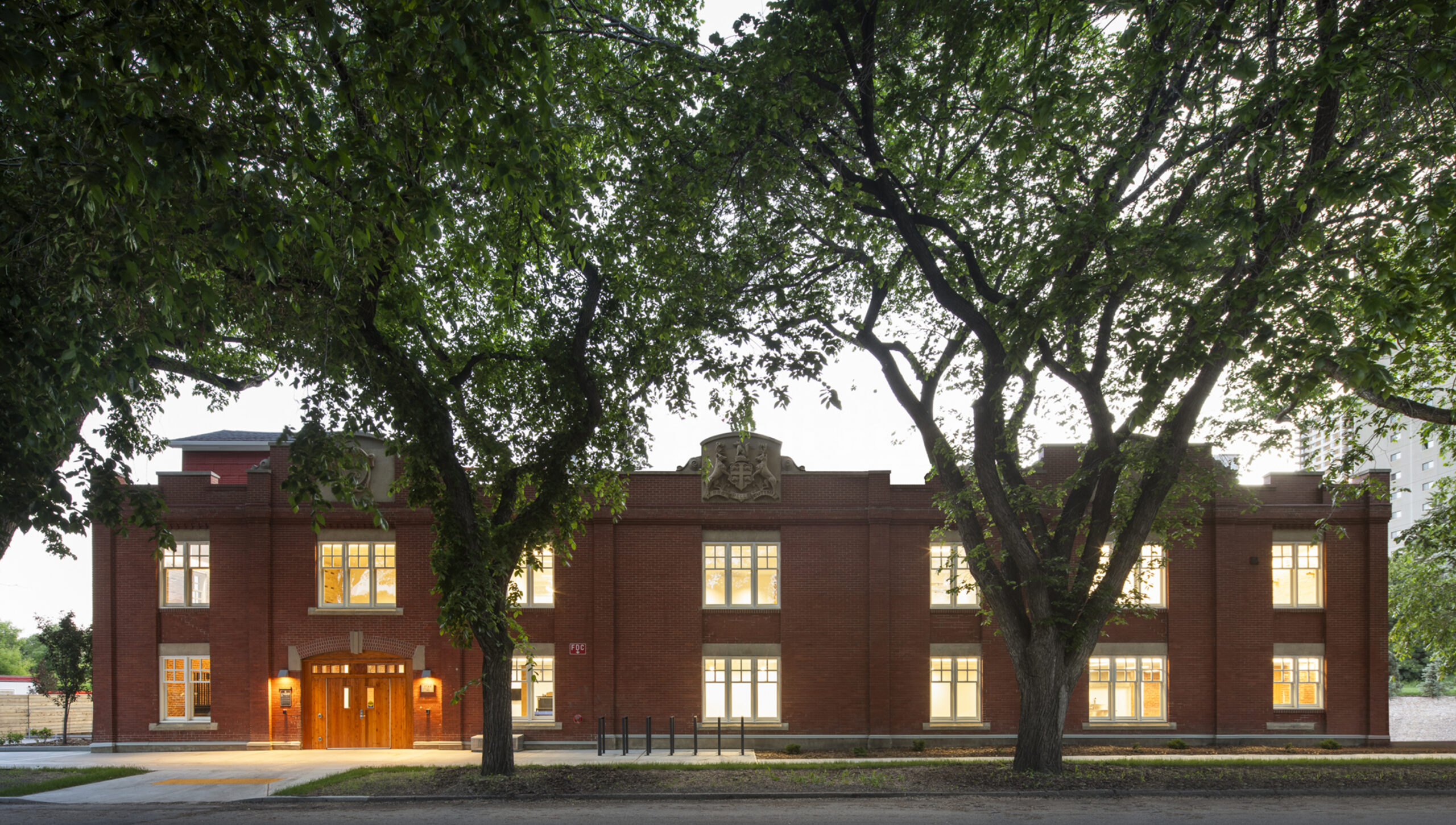
This project is a comprehensive renewal of the Ortona Armoury Arts Building, located in Edmonton’s historic Rossdale neighbourhood.
Constructed as a warehouse and stables for the Hudson’s Bay Company in 1914, the building has served a broad range of functions over the past century, including a home for the Edmonton Pure Butter Company, a base for the Royal Canadian Navy, and, for the past 40 years, a creative hub for a wide range of artists.
In 2004, the Armoury was acquired by the City of Edmonton and designated as a municipal historic resource.
Over the past two decades, a number of modest revitalization projects have restored elements of the building, including the reinstatement of the HBC sandstone cartouches on its East elevation and the repointing of some of its exterior masonry walls. Despite these efforts, the building was in dire need of more involved rehabilitation, including the addition of a ventilation system; the abatement of hazardous materials; the restoration of its historic exterior windows, and significant upgrades to bring the building into compliance with current building and energy performance codes.
The project navigates the rehabilitation process by evaluating design decisions through four primary lenses: a desire to honour arts culture; an imperative to protect the building’s heritage; a requirement to improve energy efficiency; and a need to optimize program spaces for future leasing considerations.
The design responds to this multifaceted mandate through both additive and subtractive operations. In order to address some of the building’s building code deficiencies (chiefly its lack of exits) and to provide a double height, multi-purpose art production and display space, the existing courtyard is infilled with a contemporary addition that gives the building a gregarious new presence in the community. This newly enclosed courtyard also effectively converts a number of exterior walls into interior ones, improving energy performance and allowing the existing masonry walls to be expressed on both the interior and the exterior. A new mechanical penthouse clad in illuminated polycarbonate houses many of the new services for the building while also functioning as urban scale signage.
Throughout the building, non-structural partitions and other elements are removed or simplified to better express the building’s structural and material heritage and to create more open-ended infrastructure for cultural production and dissemination. New wall assemblies include plywood backing to support frequent mounting and demounting of artwork, while new lighting infrastructure permits considerable reconfiguration and customization by individual tenants. Where erosions are made in existing interior walls and floors, painted steel frames demarcate the line between new and existing construction by way of a conscious reveal between these two conditions.
The project extends the distinction between existing and new construction to the exterior, where mill finished and anodized aluminum form the primary materials of the new addition. This material vocabulary is manifest as an array of perforated aluminum solar shading fins that screen the glazed elevation of the courtyard infill; a new entry canopy that gives the existing building entrance greater legibility; and composite aluminum panels that clad the non-glazed surfaces of the infill.
In order to better connect the building with Rossdale and Edmonton’s cultural landscape more broadly, the project site is subtly enhanced with hard and soft landscaping and other amenities to support a wide variety of outdoor programming opportunities and pedestrian access points, both anticipating and catalyzing the realization of Edmonton’s River Crossing master plan for the area.
Photo Credit: Adrien Williams
This project is a comprehensive renewal of the Ortona Armoury Arts Building, located in Edmonton’s historic Rossdale neighbourhood.
Constructed as a warehouse and stables for the Hudson’s Bay Company in 1914, the building has served a broad range of functions over the past century, including a home for the Edmonton Pure Butter Company, a base for the Royal Canadian Navy, and, for the past 40 years, a creative hub for a wide range of artists.
In 2004, the Armoury was acquired by the City of Edmonton and designated as a municipal historic resource.
Over the past two decades, a number of modest revitalization projects have restored elements of the building, including the reinstatement of the HBC sandstone cartouches on its East elevation and the repointing of some of its exterior masonry walls. Despite these efforts, the building was in dire need of more involved rehabilitation, including the addition of a ventilation system; the abatement of hazardous materials; the restoration of its historic exterior windows, and significant upgrades to bring the building into compliance with current building and energy performance codes.
The project navigates the rehabilitation process by evaluating design decisions through four primary lenses: a desire to honour arts culture; an imperative to protect the building’s heritage; a requirement to improve energy efficiency; and a need to optimize program spaces for future leasing considerations.
The design responds to this multifaceted mandate through both additive and subtractive operations. In order to address some of the building’s building code deficiencies (chiefly its lack of exits) and to provide a double height, multi-purpose art production and display space, the existing courtyard is infilled with a contemporary addition that gives the building a gregarious new presence in the community. This newly enclosed courtyard also effectively converts a number of exterior walls into interior ones, improving energy performance and allowing the existing masonry walls to be expressed on both the interior and the exterior. A new mechanical penthouse clad in illuminated polycarbonate houses many of the new services for the building while also functioning as urban scale signage.
Throughout the building, non-structural partitions and other elements are removed or simplified to better express the building’s structural and material heritage and to create more open-ended infrastructure for cultural production and dissemination. New wall assemblies include plywood backing to support frequent mounting and demounting of artwork, while new lighting infrastructure permits considerable reconfiguration and customization by individual tenants. Where erosions are made in existing interior walls and floors, painted steel frames demarcate the line between new and existing construction by way of a conscious reveal between these two conditions.
The project extends the distinction between existing and new construction to the exterior, where mill finished and anodized aluminum form the primary materials of the new addition. This material vocabulary is manifest as an array of perforated aluminum solar shading fins that screen the glazed elevation of the courtyard infill; a new entry canopy that gives the existing building entrance greater legibility; and composite aluminum panels that clad the non-glazed surfaces of the infill.
In order to better connect the building with Rossdale and Edmonton’s cultural landscape more broadly, the project site is subtly enhanced with hard and soft landscaping and other amenities to support a wide variety of outdoor programming opportunities and pedestrian access points, both anticipating and catalyzing the realization of Edmonton’s River Crossing master plan for the area.
Photo Credit: Adrien Williams
